From August 2023 the comments on statistics, a short description of selected, recently issued statistical data in the area of monetary statistics and the non-residents sector statistics, are no longer published. They are replaced by Statistical releases.
Comments on the balance of payments, gross external debt and the international investment position in 1Q 2022
The current and capital account of the balance of payments ran a deficit of EUR 2.1bn in the first quarter of 2022, with the result that the balance deteriorated by EUR 1.1bn from the same period in the previous year. This was in particular due to the worsening of the balance of foreign trade in goods resulting from rising price pressures, which was mainly related to an increase in net imports of energy products. If the last four quarters are observed, the surplus in the current and capital account in the period up to the end of March 2022 amounted to 3.7% of GDP, which is a decrease of 2.1 percentage points from the whole of 2021.
In line with the current and capital account deficit, the financial account of the balance of payments saw a significant net capital inflow. Gross external debt stood at 76.7% of GDP at the end of March 2022, down by 1.2 percentage points from the end of December in the previous year, the decrease being entirely due to nominal GDP growth, while debt increased in absolute terms. The relative indicator of the net international investment position worsened from –34.0% of GDP at the end of 2021 to –37.5% of GDP at the end of March 2022, primarily due to an increase in net external debt, especially the deterioration of the net foreign position of credit institutions.
The current and capital account of the balance of payments ran a deficit of EUR 2.1bn in the first quarter of 2022, with the result that the balance deteriorated by EUR 1.1bn from the same period in the previous year (Figure 1a). This was almost completely due to a sharp increase in the foreign trade in goods deficit. At the same time, the surplus in the primary income account and the total surplus in the secondary income and capital transaction accounts only slightly decreased, whereas unfavourable developments were partly mitigated by the growth of net exports of services (Table 1). If the last four quarters are observed, the surplus in the current and capital account in the period up to the end of March 2022 totalled 3.7% of GDP, which is a decrease of 2.1 percentage points from the whole of 2021.
The growth of foreign trade in goods additionally accelerated in the first three months of 2022, with the annual growth rate of total goods exports (46.6%) only slightly exceeding that of goods imports (44.2%). Nevertheless, due to a markedly higher imports base, the foreign trade deficit widened sharply by EUR 1.0bn from the same period in the previous year. Goods exports and imports grew at very high rates, strongly reflecting the growth of goods prices, especially the prices of energy products and other raw materials in the global market. On the other hand, net exports of services edged up by EUR 0.1bn, thanks mainly to a rise in income from tourist spending of foreign guests, which more than doubled in the first quarter of 2022 from the same period in the previous year, exceeding the record 2019 level by 1.8%. However, the impact of income growth was somewhat mitigated by a large increase in expenditures related to tourist consumption of residents abroad from the same period in the previous year, which, however, still have not reached the pre-pandemic level.
The primary income account surplus dropped by EUR 0.1bn at the beginning of 2022 as a result of an increase in expenditures on direct equity investments in Croatia (i.e., a rise in the profits of banks and enterprises in foreign ownership), which was only partly offset by the continued growth of revenues from compensation of persons temporarily employed abroad. The overall surplus in the secondary income and capital transaction accounts also decreased (by EUR 0.1bn) from the same period in the previous year, the main cause being the weaker net absorption of EU funds.
Figure 1 Balance of payments
| a) Current and capital account | b) Financial account |
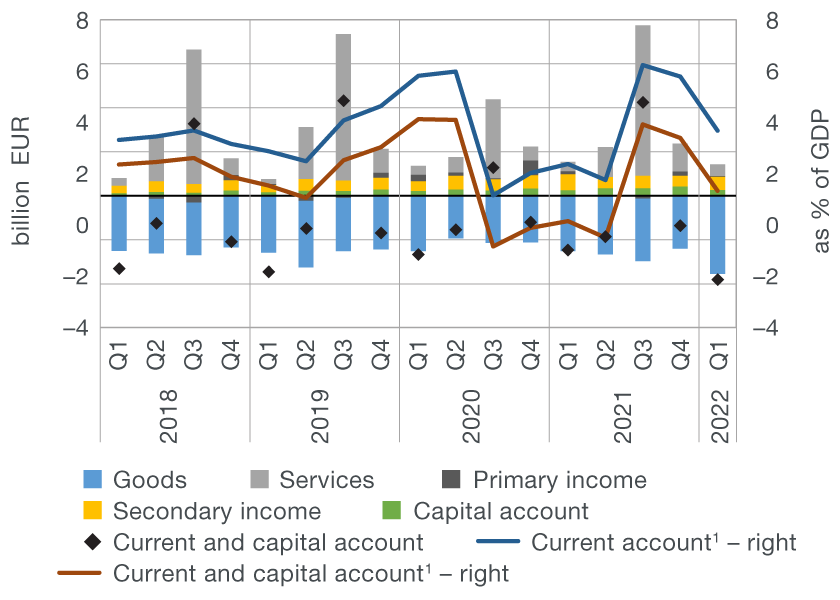 |
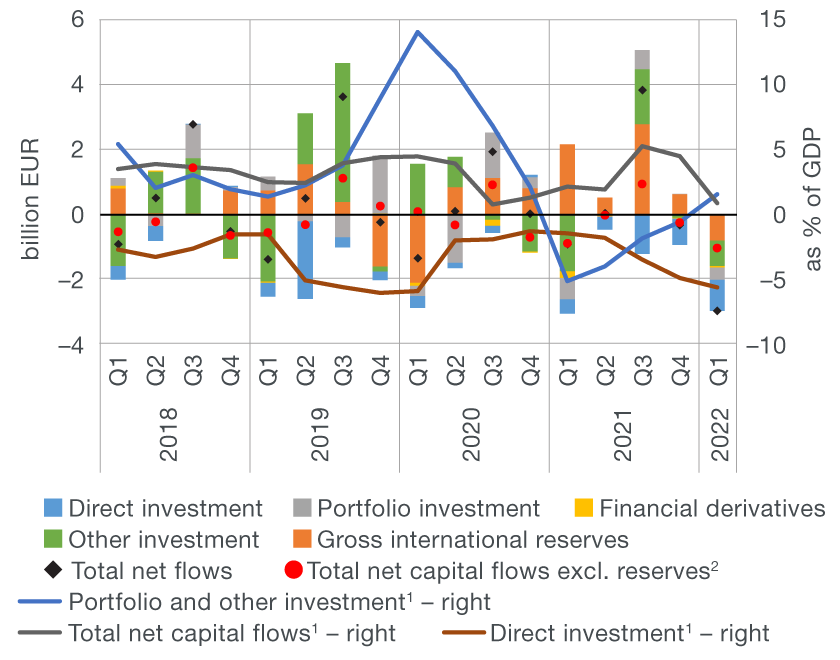 |
1 Sum of the last four quarters.
2Excluding the change in the gross international reserves and foreign liabilities of the CNB.
Note: In the figure showing the financial account, the positive value denotes net capital outflow abroad and the negative value denotes net capital inflow.
Source: CNB.
The financial account of the balance of payments recorded a net capital inflow of EUR 3.0bn in the first quarter of 2022, which is a substantial increase (EUR 2.1bn) from the same period in the previous year (Figure 1b), resulting from a strong net inflow in all sub-accounts.
In the first three months of 2022, net inflow of foreign direct investments amounted to a notable EUR 1.0bn, due to an increase in liabilities mainly related to retained profit accounted for by the improved business results of banks and enterprises in foreign ownership. Debt liabilities and direct equity investments in Croatia, realised mostly in the real estate sector, rose slightly less.
Net capital inflow in the other investment account (EUR 0.8bn) in the first quarter of 2022 was due to an increase in liabilities and an even sharper decrease in the foreign assets of domestic sectors. The growth of foreign liabilities of banks and short-term liabilities of other domestic sectors (especially those deriving from trade credits) was to a large extent alleviated by a drop in the foreign liabilities of the central bank resulting from a decrease in the volume of repo transactions, which have a neutral impact on overall developments in the financial account (see note in Table 1). In contrast, banks made the largest contribution to a decrease in foreign assets, which was only partly offset by the growth of government debt claims due to the amount of funds distributed to end-users exceeding the amount received from the EU budget.
The portfolio investment account recorded a net capital inflow of EUR 0.4bn due to the fact that a decrease in assets triggered by the investments of residents in foreign shares and equity holdings was accompanied by an increase in government foreign liabilities on long-term debt securities arising from secondary market transactions.
Gross international reserves decreased by EUR 0.8bn in the first quarter of 2022, standing at EUR 24.1bn at the end of March 2022. EUR. This was primarily caused by the already mentioned decrease in the volume of repo transactions, which has no impact on the CNB’s net foreign position (see note in Table 1) and, to a smaller degree, by foreign exchange interventions carried out in March.
Table 1 Balance of payments
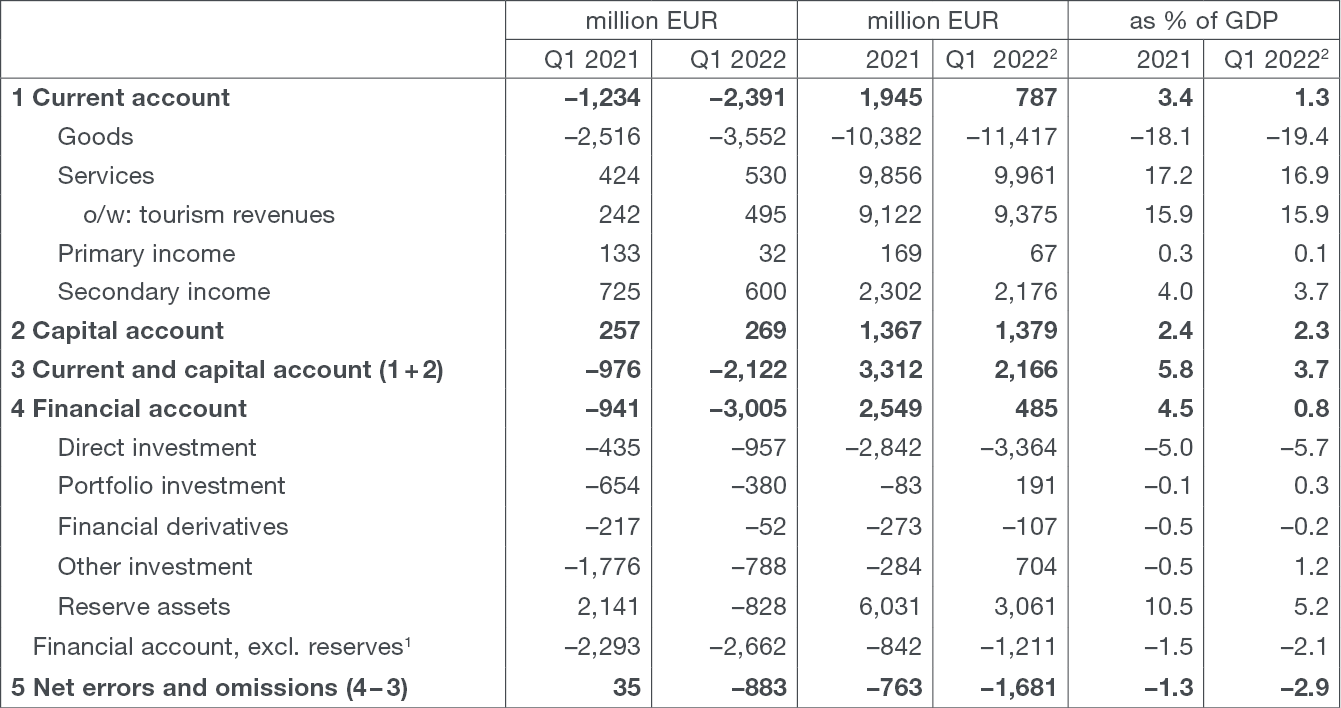
1Excluding the change in the gross international reserves and foreign liabilities of the CNB. The investment of a portion of international reserves in reverse repo agreements results in a simultaneous change in CNB assets (recorded in the reserve assets account) and liabilities (recorded in the other investment account) and thus has a neutral impact both on changes in the central bank’s net foreign position and the overall financial account balance.
2Sum of the last four quarters.
Note: The positive value of financial transactions denotes net capital outflow abroad and the negative value denotes net capital inflow.
Source: CNB.
The gross external debt stock stood at EUR 45.2bn at the end of March 2022, up by EUR 0.6bn from the end of December in the previous year (Figure 2a). The increase resulted from the growth of debt of all domestic sectors, with the exception of the central bank, whose gross external debt stock dropped by EUR 0.5bn due to a reduced volume of repo transactions. In contrast, increases were recorded in the gross external debt of credit institutions (EUR 0.6bn), other domestic sectors, including liabilities towards affiliated creditors abroad (EUR 0.3bn) and the government (EUR 0.2bn). Although debt grew in absolute terms, due to a sharp increase in GDP in the first quarter the relative indicator of gross external debt improved by 1.2 percentage points from the end of 2021, amounting to 76.7% of GDP at the end of March 2022 (Figure 2b).
Figure 2 Gross external debt
| a) Change in gross external debt | b) Stock of gross external debt |
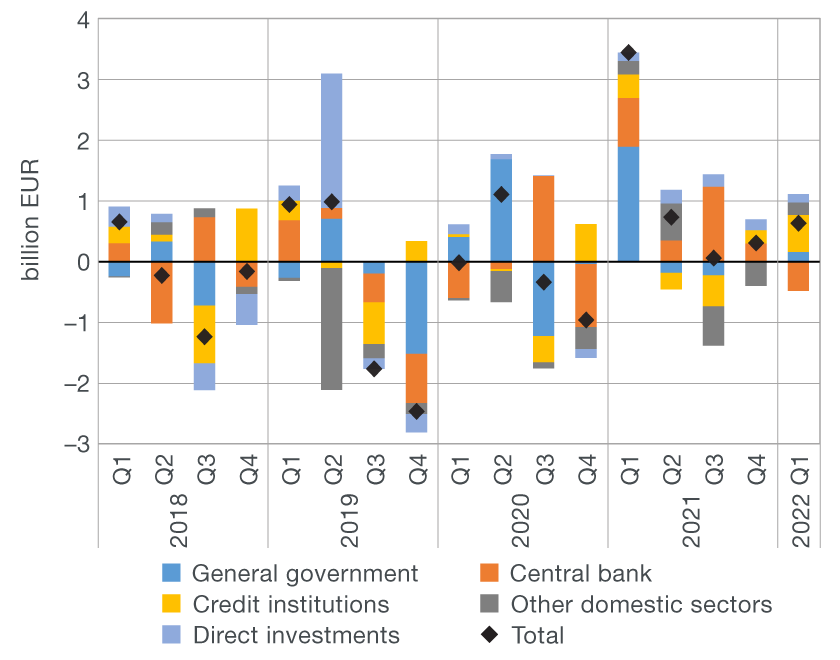 |
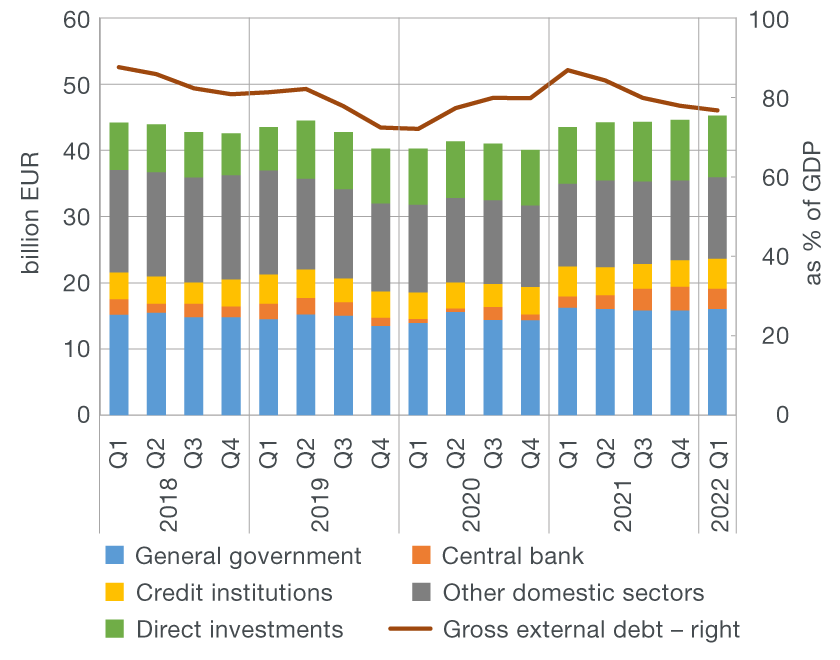 |
Note: Changes in gross external debt are a result of net transactions of domestic sectors and exchange rate and other adjustments.
Source: CNB.
The strong growth of net external debt (EUR 2.6bn) in the first three months of 2022 exceeded the gross external debt growth because of a parallel sharp decrease in foreign debt claims. The net debt position of all domestic sectors worsened, most of all that of credit institutions. Net external debt amounted to EUR 4.9bn (8.3% of GDP) at the end of March, rising by 4.3 percentage points from the end of December 2021.
The net international investment position deteriorated from EUR –19.4bn at the end of December in the previous year to EUR –22.1bn at the end of March 2022. This was primarily due to the growth of net external debt, aided by a slight increase in net equity liabilities, which was only partially offset by the positive impact of price, exchange rate and other adjustments. Broken down by individual sectors (Figure 3a), the net foreign position of credit institutions and other domestic sectors deteriorated the most, the net foreign position of the central bank deteriorated to a somewhat lower degree and the government’s net foreign position worsened only slightly. Accordingly, the relative indicator of the net international investment position worsened to –37.5% of GDP at the end of March 2022 from –34.0% of GDP at the end of December in the previous year (Figure 3b).
Figure 3 International investment position (net)
| a) Position by sector | b) Relative indicator by type of investment |
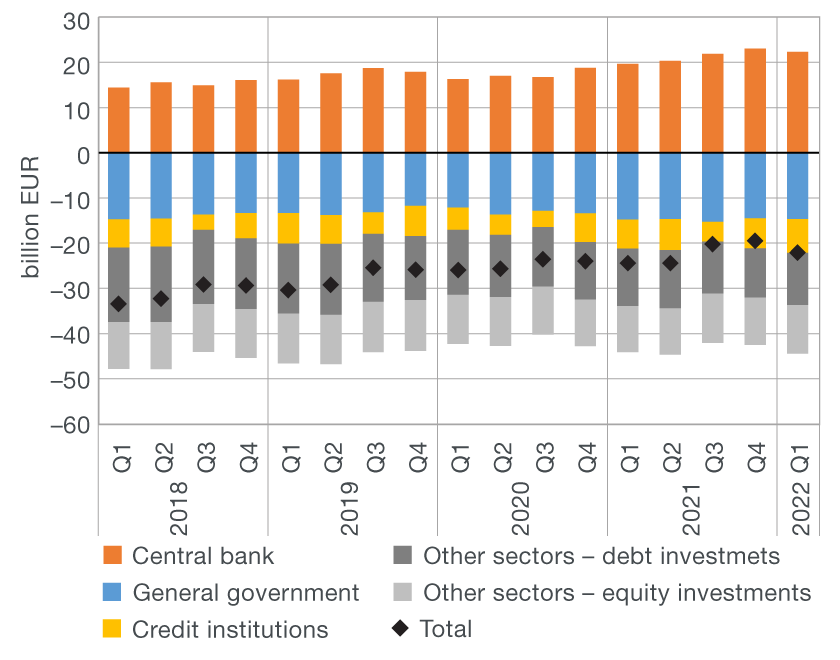 |
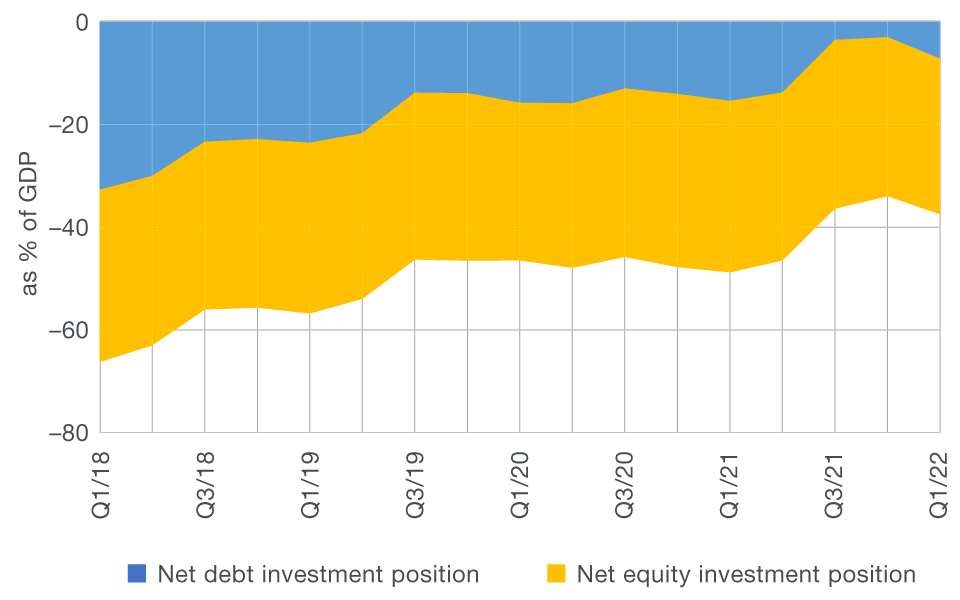 |
Note: The international investment position (net) equals the difference between domestic sectors' foreign assets and liabilities at the end of a period. The negative value of the net international investment position indicates that foreign liabilities of Croatian residents are greater than their foreign assets. Included are assets and liabilities based on debt instruments, equity investments, financial derivatives, and other instruments. Figure 3b includes financial derivatives and other liabilities.
Source: CNB.
Data revision
Data on the balance of payments, gross external debt and the international investment position are revised in accordance with the commonly used practice, based on subsequently available data.
Detailed balance of payments data
Detailed gross external debt data
Detailed data on the international investment position
